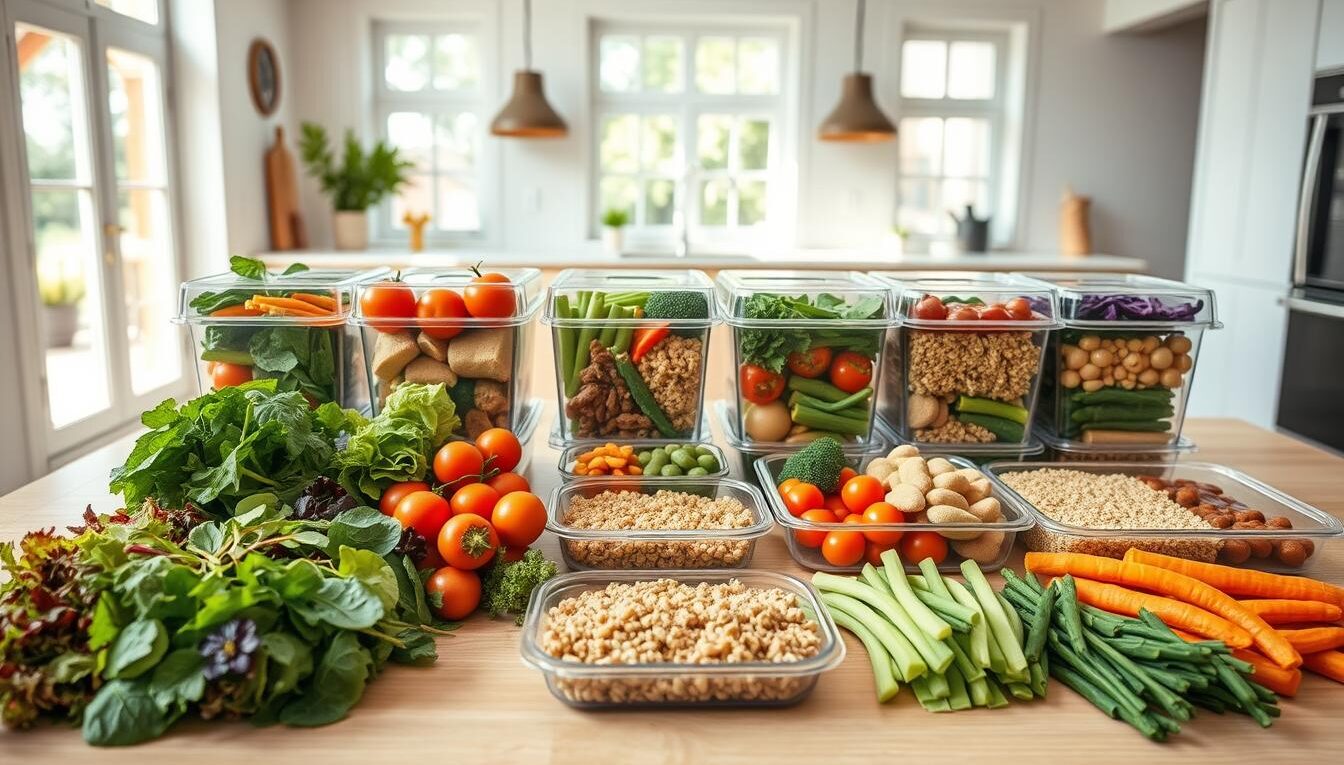Crafting a Balanced Meal Plan for the Week Ahead
Planning your meals in advance is a simple yet effective way to maintain a healthy eating habit. By deciding on your meals for the week, you can ensure that you’re consuming a balanced diet rich in nutrients. This approach not only saves time but also helps in avoiding last-minute, often unhealthy, food choices.
Adopting a weekly meal planning strategy can significantly impact your overall well-being. It allows you to incorporate a variety of foods, including those that support natural detoxification methods and holistic detoxification techniques. By doing so, you’re not only nourishing your body but also potentially enhancing your body’s natural cleansing processes.
Key Takeaways
- Plan your meals in advance to save time and ensure healthy eating.
- Incorporate a variety of nutrient-rich foods into your meal plan.
- Consider your dietary needs and preferences when planning meals.
- A balanced meal plan supports overall well-being and natural detoxification.
- Weekly meal planning can help avoid unhealthy last-minute food choices.
The Benefits of Weekly Meal Planning
By dedicating a few minutes each week to meal planning, you can take a significant step towards a healthier lifestyle. Weekly meal planning offers numerous benefits, from saving time and money to reducing food waste and supporting your nutritional goals.
Saving Time and Money
One of the most significant advantages of weekly meal planning is the potential to save both time and money. By planning your meals in advance, you can create a more efficient grocery list, reducing the need for last-minute takeouts or dining out. This not only saves money but also cuts down on the time spent deciding what to eat or waiting for food.
Time-saving tips:
- Prepare meals in bulk to save cooking time during the week.
- Use a meal planning app to organize your recipes and grocery lists.
- Keep a well-stocked pantry to quickly assemble meals.
Reducing Food Waste
Weekly meal planning also helps in reducing food waste by ensuring that you use up all the ingredients you buy. By planning your meals around what’s on sale or in season, you can make the most of your grocery purchases.
| Food Item | Quantity | Meal Idea |
|---|---|---|
| Chicken Breast | 2 lbs | Grilled chicken salads, chicken stir-fry |
| Carrots | 1 bunch | Snacks, stews, salads |
| Quinoa | 2 bags | Side dishes, salads, breakfast bowls |
Supporting Nutritional Goals
Perhaps most importantly, weekly meal planning supports your nutritional goals by allowing you to plan balanced, healthy meals. By considering your dietary needs and preferences, you can create a meal plan that nourishes your body.
Nutritional tips:
- Include a variety of colors on your plate to ensure a range of vitamins and minerals.
- Balance your meals with proteins, healthy fats, and complex carbohydrates.
- Stay hydrated by drinking plenty of water throughout the day.
By incorporating weekly meal planning into your routine, you can enjoy the benefits of saving time and money, reducing food waste, and supporting your nutritional goals. Start planning your meals today to take the first step towards a healthier, more balanced lifestyle.
Understanding Balanced Nutrition Basics
Understanding the basics of balanced nutrition is key to making informed dietary choices. A balanced diet provides your body with the necessary nutrients, vitamins, and minerals to function optimally. It’s about consuming the right amounts of different food groups to support your overall health and well-being.
Macronutrients: Proteins, Carbs, and Fats
Macronutrients are the body’s primary source of energy and are crucial for various bodily functions. They are categorized into three main groups: proteins, carbohydrates, and fats.
- Proteins are essential for building and repairing tissues, including muscles, bones, and skin.
- Carbohydrates are the body’s primary energy source, found in foods like grains, fruits, and vegetables.
- Fats play a critical role in energy production, brain function, and the absorption of vitamins.
Optimal Ratios for Different Goals
The ideal ratio of macronutrients can vary based on individual health goals, activity levels, and dietary preferences. For instance, someone looking to build muscle might require a higher protein intake, while an athlete might need a different balance to optimize performance.
| Goal | Protein (%) | Carbohydrates (%) | Fats (%) |
|---|---|---|---|
| General Health | 15-20 | 45-65 | 20-35 |
| Muscle Building | 25-30 | 40-60 | 20-30 |
| Endurance | 15-20 | 60-70 | 15-25 |
Micronutrients: Vitamins and Minerals
Micronutrients, though required in smaller amounts, are vital for maintaining healthy bodily functions. They include vitamins and minerals that support a wide range of processes, from immune function to nerve function.
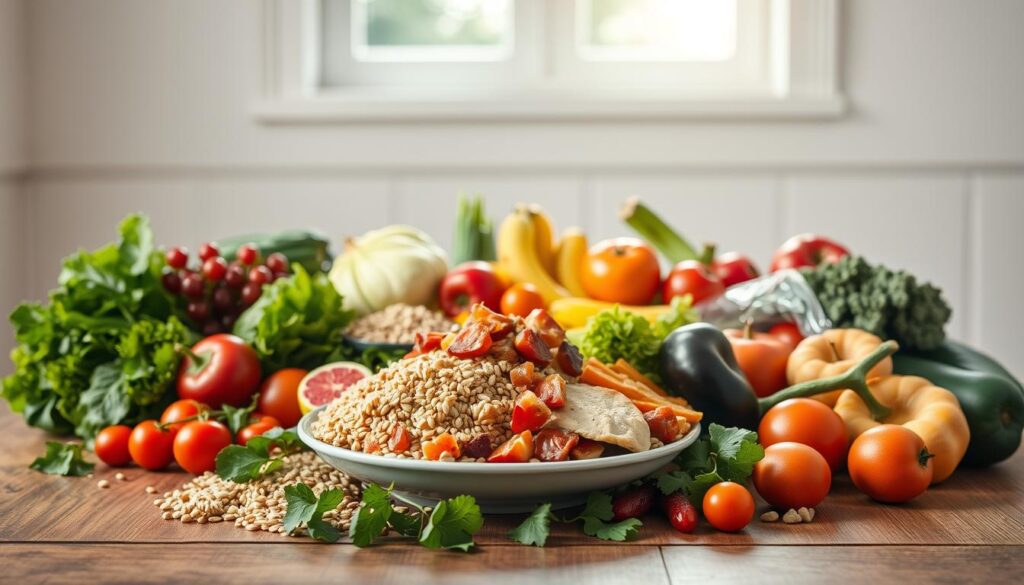
Portion Control and Caloric Needs
Understanding your caloric needs and practicing portion control are crucial aspects of balanced nutrition. Your caloric needs depend on factors like age, gender, weight, height, and activity level.
To maintain a healthy weight, you need to balance the calories you consume with the calories you burn. Using a detox diet plan at home or any dietary plan effectively requires understanding and managing your caloric intake.
Assessing Your Dietary Needs and Preferences
Before planning your meals, it’s essential to assess your dietary requirements and preferences. This step is crucial in creating a meal plan that not only nourishes your body but also satisfies your taste buds.
Identifying Personal Health Goals
Understanding your personal health goals is the foundation of a successful meal plan. Are you looking to lose weight, gain muscle, or simply maintain a healthy lifestyle? Your health goals will dictate the types of foods you should include in your diet.
For instance, if your goal is to lose weight, you may need to focus on reducing your caloric intake while increasing your consumption of nutrient-dense foods. On the other hand, if you’re aiming to gain muscle, you’ll need to ensure you’re consuming enough protein to support muscle growth.
“The food you eat can either be the safest and most powerful form of medicine or the slowest form of poison.” – Ann Wigmore
Accounting for Allergies and Restrictions
It’s also vital to consider any dietary allergies or restrictions you may have. This includes food allergies, intolerances, and personal choices such as vegetarian or vegan diets.
- Identify any food allergies or intolerances you have.
- Consider your dietary preferences, such as vegan, gluten-free, or dairy-free.
- Be aware of any cultural or religious dietary restrictions.
| Dietary Restriction | Foods to Avoid | Alternative Foods |
|---|---|---|
| Gluten-Free | Wheat, barley, rye | Rice, quinoa, gluten-free bread |
| Vegan | Animal products, dairy, eggs | Plant-based milk, tofu, vegan cheese |
| Dairy-Free | Milk, cheese, yogurt | Almond milk, soy yogurt, coconut milk |
Balancing Nutrition with Taste Preferences
While nutrition is a critical aspect of a meal plan, it’s equally important to consider your taste preferences. A meal plan that doesn’t satisfy your taste buds is unlikely to be sustainable in the long term.
Tips for Balancing Nutrition and Taste:
- Experiment with new recipes and flavors to keep your meals interesting.
- Incorporate your favorite foods into your meal plan.
- Don’t be afraid to try new ingredients and cuisines.
By assessing your dietary needs and preferences, you can create a meal plan that is both nutritious and enjoyable. This approach will help you achieve your health goals while maintaining a positive relationship with food.
How to Build a Balanced Meal Plan for the Week
Building a balanced meal plan is a straightforward process when broken down into manageable steps. By following a simple, structured approach, you can create a meal plan that meets your nutritional needs and fits your lifestyle.
Step-by-Step Planning Process
To start, you’ll need to assess your dietary requirements and preferences. This involves considering your personal health goals, any dietary restrictions, and your taste preferences. A well-planned meal plan is tailored to your individual needs, ensuring you get the right balance of nutrients.
Template for Weekly Planning
A weekly planning template can be a valuable tool. It helps you organize your meals, ensure variety, and avoid last-minute decisions that might derail your dietary goals. Here’s a simple template you can follow:
- Monday: Breakfast, Lunch, Dinner
- Tuesday: Breakfast, Lunch, Dinner
- Wednesday: Breakfast, Lunch, Dinner
- Thursday: Breakfast, Lunch, Dinner
- Friday: Breakfast, Lunch, Dinner
- Saturday: Breakfast, Lunch, Dinner
- Sunday: Breakfast, Lunch, Dinner
Creating a Diverse Menu
A diverse menu is key to a successful meal plan. It ensures you’re getting a wide range of nutrients and keeps mealtime interesting. To create a diverse menu, consider including a variety of:
- Proteins: chicken, fish, beans, tofu
- Vegetables: leafy greens, broccoli, bell peppers
- Fruits: berries, citrus fruits, apples
- Grains: brown rice, quinoa, whole wheat bread
Experimenting with new recipes and ingredients can also help keep your diet interesting and prevent boredom.
Incorporating Seasonal Foods
Incorporating seasonal foods into your meal plan can be beneficial for several reasons. Seasonal foods are often fresher, taste better, and are more nutritious. They can also be more cost-effective and environmentally friendly. To incorporate seasonal foods, check local farmers’ markets or grocery stores to see what’s in season.
Some benefits of seasonal foods include:
- Improved flavor and texture
- Higher nutritional value
- Lower environmental impact
- Cost savings
Essential Tools and Resources for Meal Planning
Meal planning can be simplified with the right combination of digital and physical tools. By leveraging these resources, you can streamline your planning process, making it more efficient and enjoyable.
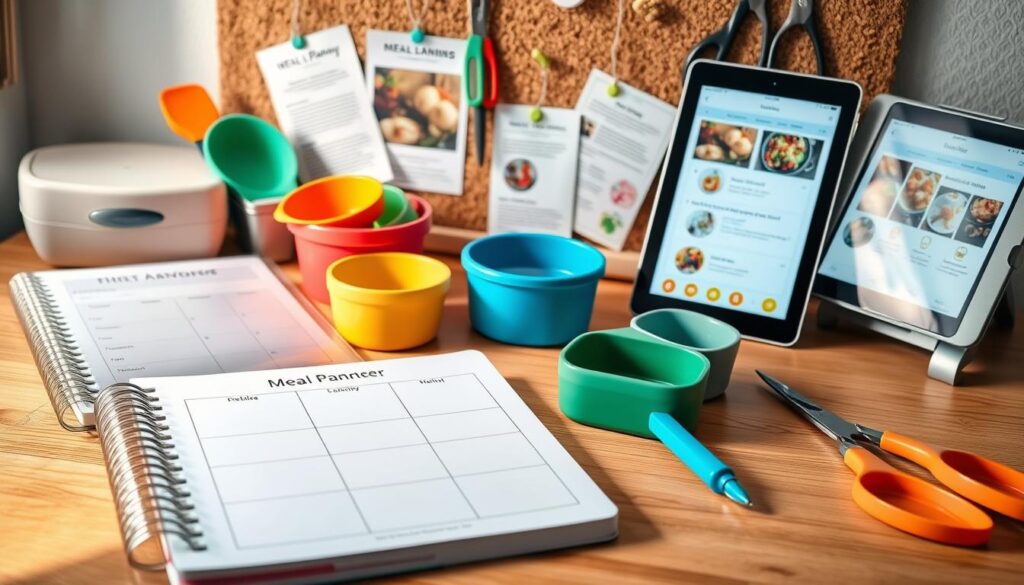
Digital Apps and Planners
Digital apps and planners have revolutionized meal planning by offering convenience and accessibility. Apps like Plan to Eat and Yummly allow you to organize recipes, create shopping lists, and schedule meals with ease.
These digital tools often come with features such as nutritional information, meal suggestions based on dietary preferences, and the ability to import recipes from various sources. By utilizing these apps, you can keep your meal planning organized and on track.
Recipe Databases and Cookbooks
Having access to a variety of recipes is crucial for maintaining a diverse meal plan. Recipe databases and cookbooks are invaluable resources, offering a wide range of culinary ideas and inspiration.
Cookbooks provide a tactile experience, allowing you to flip through pages and discover new recipes. Meanwhile, online recipe databases offer the convenience of searching by ingredient, dietary restriction, or cooking time. Popular cookbooks like “The Blue Zones Kitchen” and websites such as Allrecipes are excellent starting points.
Kitchen Equipment for Efficient Cooking
Having the right kitchen equipment can significantly enhance your cooking efficiency. Essential tools include a slow cooker, immersion blender, and quality knives. These tools can simplify meal preparation and reduce cooking time.
Investing in a good set of kitchen equipment not only makes cooking more enjoyable but also helps in preparing healthy meals consistently. By combining these tools with your meal planning resources, you’ll be well on your way to a more streamlined and effective cooking process.
Smart Grocery Shopping Strategies
Smart grocery shopping is about more than just buying food; it’s about making informed choices that nourish your body. Effective grocery shopping can significantly impact your meal plan’s success, saving you time and money while reducing food waste.
Creating Effective Shopping Lists
Creating a well-organized shopping list is the first step towards efficient grocery shopping. Start by planning your meals for the week, then make a list of the ingredients you need. Organize your list by categories, such as produce, dairy, and meats, to make your shopping trip more streamlined.
Consider using digital apps or planners to keep your list organized and accessible. Many apps allow you to check off items as you shop, helping you stay on track.
Budgeting Tips for Nutritious Foods
Eating nutritious food doesn’t have to break the bank. Plan your meals around seasonal produce, which is often cheaper and fresher. Buying in bulk can also save you money, especially for non-perishable items.
As
“You are what you eat,”
so investing in quality food is investing in your health. Look for sales and stock up on healthy staples like whole grains, beans, and canned tomatoes.
Navigating the Grocery Store Efficiently
Knowing the layout of your grocery store can save you time and reduce impulse buys. Typically, the healthiest options are found on the perimeter of the store, such as fresh produce, meats, and dairy products.

Shop the sales and stock up on non-perishable items. Avoid shopping when you’re hungry to prevent impulse buying. By being mindful of your shopping habits, you can stick to your list and budget.
By implementing these smart grocery shopping strategies, you’ll be well on your way to creating a balanced meal plan that nourishes your body and supports your health goals.
Meal Prep Techniques to Save Time
With the right meal prep techniques, you can enjoy a week’s worth of healthy meals without spending hours in the kitchen. Meal prep is all about efficiency and planning. By dedicating a few hours on the weekend or one day during the week, you can prepare meals that will save you time and stress during the busy weekdays.
Batch Cooking Fundamentals
Batch cooking involves preparing large quantities of a single ingredient or an entire meal that can be portioned out and reheated as needed. This technique is a cornerstone of effective meal prep. To get started with batch cooking, focus on recipes that are easy to scale up, such as soups, stews, casseroles, and grain dishes.
- Choose recipes that freeze well to ensure you can store your batches for later use.
- Invest in a good set of containers that are airtight and freezer-safe.
- Label your containers with the date and contents to keep track of what you have stored.
Foods That Freeze Well
Not all foods are created equal when it comes to freezing. Some foods retain their texture and flavor better than others. Examples of foods that freeze well include:
- Cooked meats like chicken, beef, and pork
- Soups and stews
- Casseroles
- Cooked grains like rice and quinoa
- Vegetables like broccoli, carrots, and peas
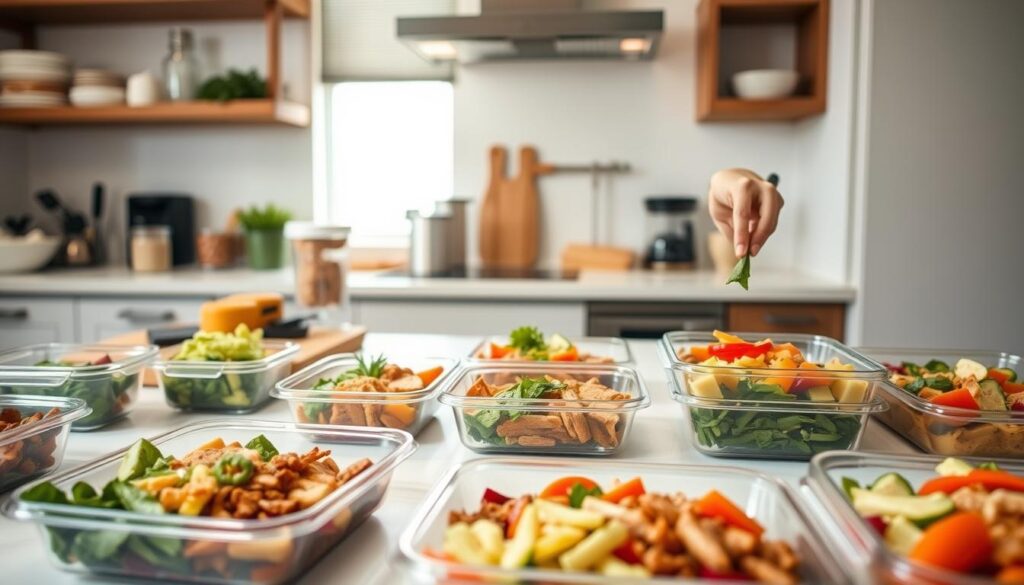
Storage Solutions and Food Safety
Proper storage is crucial for maintaining the quality and safety of your prepped meals. Use airtight containers to prevent moisture and other flavors from affecting your food. Always label your containers with the date and contents. When storing in the freezer, ensure that your containers are freezer-safe to prevent them from becoming brittle or cracking.
To maintain food safety, follow these guidelines:
- Cool cooked foods to room temperature within two hours to prevent bacterial growth.
- Store food in shallow containers to help it cool faster.
- Label leftovers with the date so you can keep track of how long they’ve been stored.
- Use the “first in, first out” rule to ensure older meals are consumed before newer ones.
Time-Saving Kitchen Hacks
Beyond batch cooking and proper storage, there are several kitchen hacks that can save you time during meal prep. For example, using a slow cooker or Instant Pot can significantly reduce the time spent on cooking. Preparing ingredients in advance, such as chopping vegetables or marinating proteins, can also streamline your cooking process.
Other time-saving tips include:
- Prepping ingredients for the week on a single day.
- Using one-pot recipes to minimize cleanup.
- Keeping your kitchen organized and your tools within easy reach.
Sample 7-Day Balanced Meal Plans
Whether you’re an omnivore, vegetarian, or vegan, having a 7-day meal plan can simplify your dietary choices and enhance your overall well-being. A well-structured meal plan not only ensures you’re getting the nutrients you need but also helps in saving time and reducing food waste.
Omnivore Meal Plan
An omnivore diet includes a variety of foods from both animal and plant sources. Here’s a sample 7-day meal plan:
- Monday: Grilled chicken with quinoa and steamed vegetables
- Tuesday: Baked salmon with brown rice and mixed greens salad
- Wednesday: Turkey and avocado wrap with sweet potato fries
- Thursday: Beef stir-fry with broccoli and brown rice
- Friday: Grilled shrimp with pasta and marinara sauce
- Saturday: Chicken Caesar salad
- Sunday: Roast beef with roasted vegetables and quinoa
Shopping List and Prep Instructions
To make the most of your omnivore meal plan, start by preparing a comprehensive shopping list. This should include:
- Proteins: chicken breast, salmon, turkey breast, beef, shrimp
- Grains: quinoa, brown rice, whole wheat wraps, pasta
- Vegetables: mixed greens, broccoli, bell peppers, onions, sweet potatoes
- Dairy: avocado, Caesar dressing
Prep instructions: Cook proteins in bulk, chop vegetables, and store them in airtight containers for easy access throughout the week.
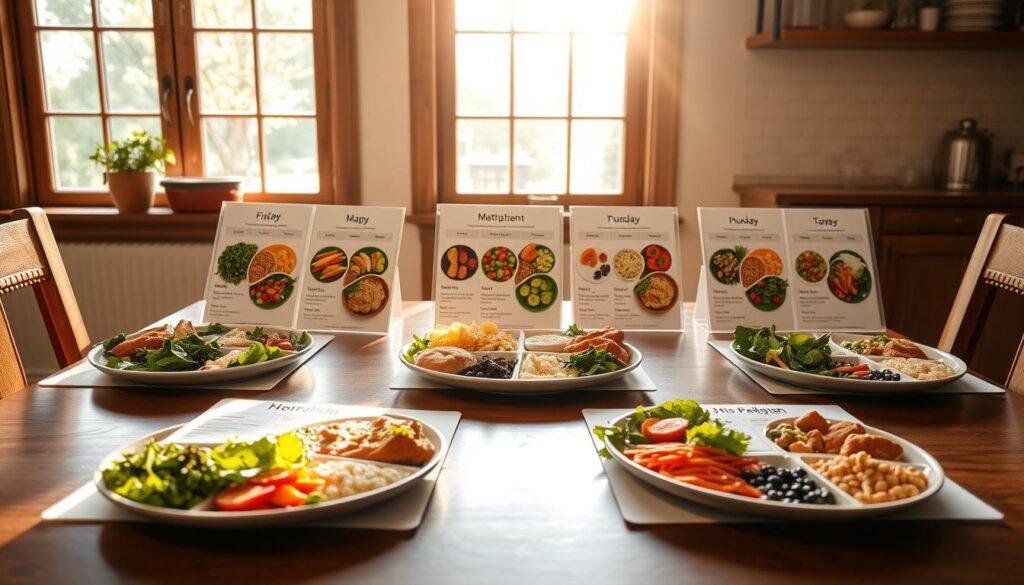
Vegetarian/Vegan Options
For those preferring a plant-based diet, here’s a sample 7-day vegetarian/vegan meal plan:
- Monday: Lentil soup with whole grain bread
- Tuesday: Grilled tofu with roasted vegetables and quinoa
- Wednesday: Vegan stir-fry with tempeh, mixed vegetables, and brown rice
- Thursday: Chickpea salad with avocado and whole grain crackers
- Friday: Vegetable curry with chickpeas and brown rice
- Saturday: Quinoa salad with roasted vegetables and vegan dressing
- Sunday: Stuffed bell peppers with quinoa, black beans, and vegetables
Budget-Friendly Meal Plan
Eating healthy doesn’t have to be expensive. Here’s a budget-friendly 7-day meal plan:
- Monday: Oatmeal with banana and almond milk
- Tuesday: Black bean and corn tacos with avocado salsa
- Wednesday: Vegetable soup with whole grain bread
- Thursday: Grilled cheese sandwich with tomato soup
- Friday: Fried rice with mixed vegetables and tofu
- Saturday: Lentil curry with brown rice
- Sunday: Breakfast for dinner – scrambled eggs with spinach and whole wheat toast
Adapting Your Meal Plan for Special Circumstances
Life is unpredictable, and your meal plan should be flexible enough to accommodate various needs and schedules. Whether you’re dealing with family commitments, striving for weight management, or navigating a hectic lifestyle, adjusting your meal plan can make a significant difference.
Family-Friendly Adjustments
When planning meals for a family, it’s essential to consider the diverse tastes and dietary needs of all members. Involving everyone in the meal planning process can help ensure that everyone’s preferences are taken into account.
- Incorporate a variety of cuisines to cater to different tastes.
- Plan meals around seasonal produce to keep the menu fresh and exciting.
- Make sure to include a balance of nutrients in each meal to support overall health.
Meal Planning for Weight Management
For those aiming to manage their weight, a well-structured meal plan is crucial. Portion control and nutrient-dense foods are key elements. Consider the following tips:
- Focus on whole foods, such as vegetables, lean proteins, and whole grains.
- Avoid processed and high-calorie foods that can hinder weight loss efforts.
- Stay hydrated by drinking plenty of water throughout the day.
| Meal | Weight Management Tips | Family-Friendly Options |
|---|---|---|
| Breakfast | Oatmeal with fruits and nuts | Pancakes with fresh fruit and yogurt |
| Lunch | Grilled chicken salad | Turkey sandwiches with carrot sticks |
| Dinner | Baked salmon with quinoa and steamed vegetables | Pasta with marinara sauce and a side salad |
Accommodating Busy Schedules
A busy schedule doesn’t have to derail your meal plan. Meal prep and slow cooker recipes can be lifesavers. Here are some strategies to make meal planning easier on the go:
- Prepare meals in advance to save time during the week.
- Use a slow cooker to cook meals that simmer throughout the day.
- Keep healthy snacks on hand to avoid relying on fast food.
By adapting your meal plan to suit your lifestyle and needs, you can maintain a healthy and balanced diet even in challenging circumstances. Remember, flexibility is key to successful meal planning.
Conclusion: Sustaining Your Meal Planning Habit
As you continue on your meal planning journey, remember that sustaining healthy habits is key to maintaining a balanced diet. By incorporating meal planning into your routine, you’re not only saving time and money but also nourishing your body with wholesome foods. This habit helps you detox your body naturally at home by focusing on nutrient-rich ingredients and minimizing food waste.
To keep your meal planning on track, regularly review and adjust your plan to suit your changing needs and preferences. Stay inspired by exploring new recipes, cooking techniques, and seasonal ingredients. By doing so, you’ll be able to maintain a balanced diet and enjoy the benefits of healthy eating.
As you sustain your meal planning habit, you’ll find that it becomes an integral part of your lifestyle, promoting overall well-being and a healthier relationship with food. Continue to make informed choices, and you’ll be on your way to achieving your nutritional goals and feeling your best.


